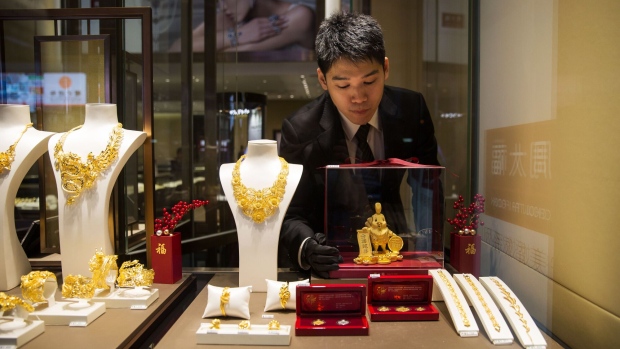Jun 8, 2023
China’s Biggest Jewelry Chain Slows Expansion to Boost Profit
, Bloomberg News

(Bloomberg) -- Chow Tai Fook Jewellery Group Ltd., one of the world’s largest jewelry retailers by market value, is dialing back expansion plans in an effort to boost profitability as the company fends off intensifying competition.
The group is planning to add 600 to 800 new stores in mainland China in the fiscal year ending March 2024, vice-chairman Sonia Cheng said in an interview Thursday, down from more than 1,500 it added over the past year. Instead, it’ll focus on increasing productivity and sales growth at existing stores, while trying to attract younger consumers, said the 42-year-old daughter of billionaire and company Chairman Henry Cheng.
The group will relaunch with a new logo and upgraded shop facilities around summer next year, starting with its flagship stores in Hong Kong and mainland China, she said.
Boosting returns in mainland China is a core focus for the group, which relies on the region for 86% of its revenue. While its fast expansion in recent years bolstered the firm’s balance sheet, making a profit has become more difficult in the country’s increasingly competitive gold market. At the same time, Chinese luxury shoppers are becoming younger and more sophisticated, demanding more unique customer experiences than older generations.
“Growth doesn’t just come with adding stores,” said Cheng, who also serves as the chief executive officer of the family’s Rosewood Hotel Group. “We must evolve the brand so that it’s relevant for the next generation.”
Profit Slump
Chow Tai Fook expanded rapidly in mainland China during the pandemic as travel restrictions and economic uncertainty fueled domestic consumption and demand for gold as a haven investment. But that came at the cost of decreased profitability, as the franchise model of most of its new stores reduced margins because products are provided to franchisees at wholesale prices.
The company reported a 20% slump in profit to HK$5.4 billion ($689 million) in the year ended March 31, missing analyst expectations, due to unrealized losses from gold loans amid price volatility and foreign exchange losses from a weakening yuan. While its profit margin of 23.7% rose from the previous year, it remained close to the lowest ever. Sales at stores that have been operating for at least two years in mainland China fell 13%. Since March 2020, it has almost doubled its network in mainland China, to more than 7,500 stores.
It also announced a full-year dividend of HK$0.50 per share, the same as the previous year, as well as a special dividend — the first since 2019 — of HK$0.72 per share. The stock surged as much as 8.7% on Friday morning in Hong Kong, the most in six months.
Business is bouncing back though, and the current year will be one of recovery and normalization, said group executive director Hamilton Cheng, who oversees the company’s financial management. Same-store sales in April and May grew 17% year-on-year in mainland China, and the group is confident growth will continue in the remainder of the year, he said.
Chow Tai Fook’s effort in reducing discounts and revamping its brand and products has helped improve margins, which are expected to continue to expand in the first half of this year, JPMorgan Chase & Co. analysts including George Hsu wrote in a note. The special dividend came as a positive surprise and shows the group’s optimism on the business outlook, Citigroup Inc. analysts including Tiffany Feng wrote in a note.
Younger Shoppers
While economic uncertainties are fueling gold demand, the metal traditionally yields a lower profit margin for retailers. Bullion prices and the cost of products at competitors like Luk Fook Holdings International Ltd. are both easily tracked by consumers, while local brands are emerging that have modeled their operations after Chow Tai Fook. Compared with gold products, which have a margin of about 20%, diamond and other gemstone jewelries have a margin of about 50%, Hamilton Cheng said.
To increase margins, the company will roll out jewelry designs aimed at younger shoppers and enhance the promotion of diamonds. The company’s “Hua” collection, which incorporates Chinese elements in modern design, now accounts for 40% of its overall gold jewelry sales and many buyers are 35 years old or younger, Sonia Cheng said.
“Post-pandemic, we are seeing a gradual recovery on consumption,” she said. The company is confident on the medium-to-long-term outlook and “based on the evolving consumer landscape with the younger generation, I think it’s time to evolve the brand so that we can stay relevant for the younger consumer,” she said.
(Updates to add shares in eighth paragraph, analysts’ comments in 10th paragraph.)
©2023 Bloomberg L.P.






